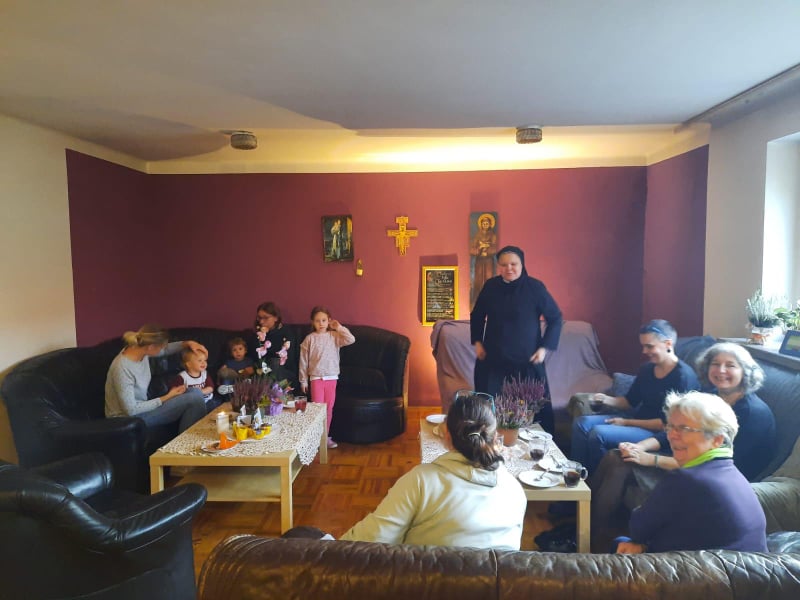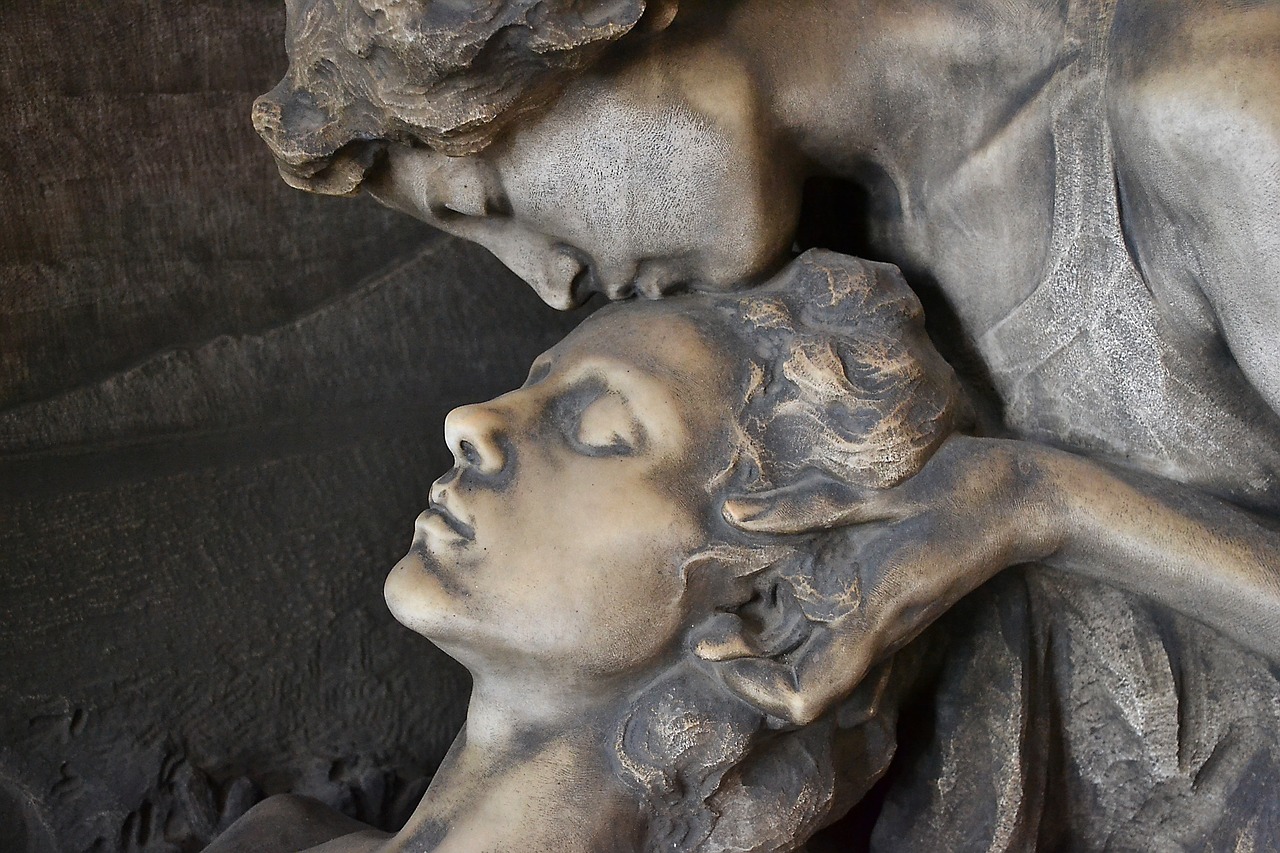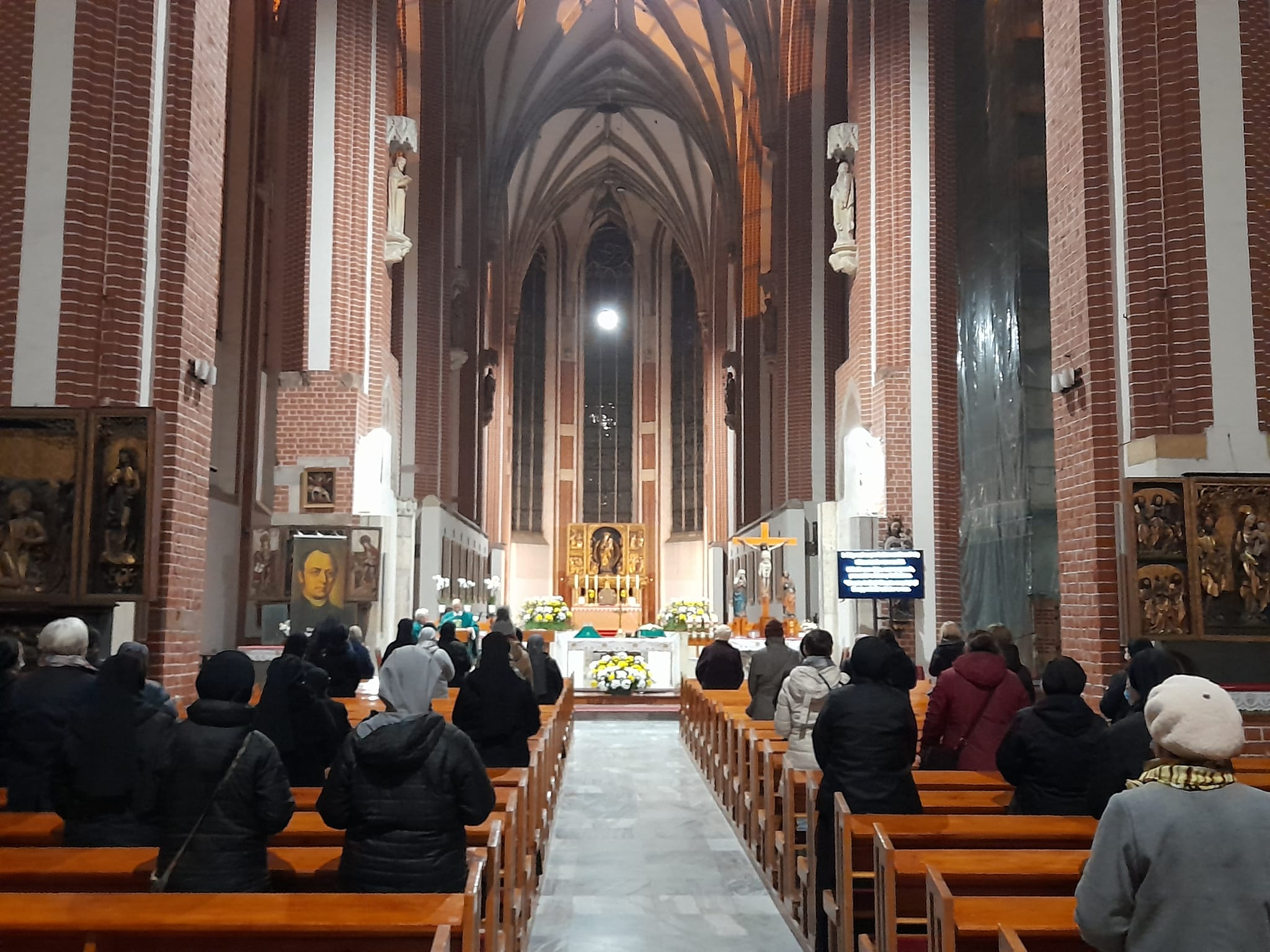
Nov 14, 2021 | NEWS
In today’s Gospel we will hear the words: My zeal for your house consumes me.
Servant of God, Fr. John Schneider was appointed administrator of the parish of St. Matthias in Wrocław on April 3, 1854. The name of the parish came from the church of St. Matthias. It was established as a court chapel associated with the court of Henry the Bearded, husband of St. Hedwig Śląska. In the 1440s, the daughter-in-law of St. Hedwig, Duchess Anna, founded a hospital dedicated to St. Elizabeth, and in 1253 she brought the Crusaders with the Red Star, creating a monastery for them, and also donated the church to the monks. In the 15th century, the temple of St. Matthias was rebuilt and enlarged.
In the 15th century, the temple of St. Matthias was rebuilt and enlarged. In 1525. the parish of St. Elizabeth, as it was taken over by Protestants. From 1638. church of St. Matthias and the monastery buildings belonged to the Jesuits, to whom we owe the reconstruction of the interior of the church and its baroque interior. St. Matthias parish functions of St. Elizabeth, he served until 1818. After the dissolution of the Jesuit Order, their monastery was converted into the Catholic gymnasium of St. Matthias, and the Church of St. Matthias became from 1813. high school church. School Holy Masses for junior high school students were celebrated there. St. Matthias was transferred to the post-Jesuit church of the Holy Name of Jesus.
The Church of the Holy Name of Jesus was founded on the initiative of the Jesuits on the site of the former prince’s castle in the years 1683-1698. It is modeled on the construction of the Church of Il Gesu in Rome and the Church of St. Ignatius in Linz. It is one of the most beautiful baroque church buildings in Silesia. It has 14 chapels next to the main altar. Near the sacristy there is a chapel dedicated to the Blessed Virgin Mary with a miraculous image of Our Lady Help of Christians of Wrocław. Under this picture, John Schneider often prayed as a theology student and then priest. The liturgical life of the parish continued in the Church of the Holy Name of Jesus.
From 11 November 1869 duties of the parish priest of St. Matthias was performed by our Founder. As a parish priest, he restored the parish church of the Name of Jesus, restored four altars, the pulpit, the tabernacle and the painting in the main altar. The main altar was made in the years 1722-1724 according to the plans of the outstanding Jesuit artist, painter and sculptor Christoph. It represents the giving of the Name of Jesus to the Savior of the world. Above the altar there is an inscription: “In the name of Jesus, let every knee bow down” (Lk II, 21). The altar is decorated with figures: the Founder of the Society of Jesuits – St. Ignatius of Loyola (+1556) and St. Francis Xavier (+1556).
In 1869, when the Servant of God was appointed parish priest, St. Matthias had 5,850 Catholics. In the parish, Fr. John Schneider worked with other five priests. The Church of the Name of Jesus, adjacent to the building of the University of Wrocław, was also a place of religious ceremonies for Wrocław professors and students. Nevertheless, our Founder, devoted his energies and pastoral concerns to the parishioners living in the parish of St. Matthias. Here he found courageous parishioners with whom he created his life’s work. It will be about that next time.
And for me, what value is my parish church?
Sr.M. Elżbieta Cińcio

Nov 9, 2021 | FORUM, NEWS
The house of Mary is a place, a space, a reality where women can strengthen themselves in faith, build bonds with one another, share their experience and support. In July this year, I participated in a summer retreat for women organized by our congregation in Nysa. The subject of considerations prepared for this time by Dr. Iwona Zielonka, who is wholeheartedly committed to the new evangelization, was “Exit from Egypt”. These days were very important to me because I discovered how much there is a need for meetings that allow another person, a woman, to strengthen her faith and share ones experience of living God. I immediately knew that a place where women could meet for a conversation or prayer could be established in Racibórz. It was God’s impulse. God’s light! For years we have been cooperating with the Franciscans from the parish of St. Paschal in Racibórz, and here I saw the opportunity to expand our cooperation and open the House of Mary, where meetings of the female hearts will be held, leading to discovering and understanding oneself in a relationship with God. Prayer, singing, conversations, renewal, closeness… Time spent together. Time to glorify God in oneself and other people. On the feast of Our Lady of the Rosary, October 7, Father Eligiusz blessed our haven. Since then, our meetings have been held once a week. It is amazing that we all feel how much we need this place. We also started a formation in the project “Holiness in the ordinary”. Once a month, we connect with other women via the Internet and take part in the days of recollection prepared by Dr. Iwona Zielonka, director for new evangelization in the diocese of Płock. The theme for this year is Blessings and Living Blessings. It is the path of God’s women who want to join their strength and experience as daughters, sisters, wives, mothers and grandmothers to form themselves in the spirit of the Gospel. After all, taking care of girls and women is the cry of our founder Fr. John Schneider, who has placed every woman and her affairs on our hearts. The House of Mary is also open to the younger parishioners. Every Saturday we meet to instill love for God in children and young people.
S.M Joanna Marcińska

Nov 5, 2021 | NEWS
On October 27, in the parish of St. Joseph in Świętochłowice on the Consensus, we had a meeting with the sisters: Natalia, Helena and Marychrista from the Congregation of the Sisters of Mary Immaculate from Tanzania. The meeting took place in the native parish of B. S.M. Dulcissima as part of the Missions Prayer Week. First, we prayed the rosary together for the mission in Swahili and Polish, then we celebrated the Holy Eucharist, during which the sisters sang Tanzanian songs. After the mass, there was a meeting with the sisters in the church, where several dozen parishioners were present. The sisters talked about their vocation, including life in Africa, and gave testimony of their meeting with Sr. Dulcissima. Finally, we entrusted the congregation, the parish and the beatification process of sister Dulcissima to God through the intercession of Our Lady and St. Joseph.
As the limited time did not allow us to follow the traces of Sister Dulcissima’s life in Zgoda, we invited the sisters to come again and see the family home of Helen Hoffmann.
We also invite everyone who is close to the life and work of sister Dulcissima Hoffmann.
Fr. Bogusław Jonczyk

Nov 4, 2021 | NEWS
Today, on the liturgical commemoration of all the departed faithful, we Sisters of Mary Immaculate gather in this Church of Our Lady in Piasek Island , which is very dear to us. In the side chapel with the stained glass window of St. Maximilian Kolbe, there are the mortal remains of our Founder. He was buried there in April 1969, after he was exhumed from the cemetery of St. Wawrzyniec, where he rested from 1944 in the quarters of the Marian Sisters. This transfer happened at the request of Cardinal Bolesław Kominek, who considered Father John Schneider a priest of merit for the Wrocław church.
With the church and parish of Our Lady in the Piasek Island, servant of God, Fr. John Schneider worked for three years – from 1851 to 1854. Bishop Melchior von Diepenbrock sent him on 9 September 1851 as a vicar for the priestly ministry in this place. Parish of the Blessed Virgin Mary in 1851 had about 1,500 believers. The parish temple was built in the years 1334-1425, in the mid-nineteenth century it had a baroque decor. The monastery of the Augustinian Fathers adjoined the temple. In 1810, the monks had to leave the monastery and church, which was taken over by the Wrocław diocese. Inside the church, there was a large pulpit and richly decorated altars and stalls, which were irretrievably destroyed during the defense of Wrocław in 1945. Our Founder is remembered by the walls of this temple, the baptismal font and the figures of angels under the ribs of the vault.
Fr. John Schneider first worked at the side of Fr. Franciszek Hoffmann, who was formally the parish priest in the years 1848-1852, and from November 12, 1852, Fr. Józef Wick. From 1848, the vicar was Fr. Robetr Spiske, with whom our Founder established a friendly relationship.
From 1848, the association of Catholic Married Women under the invocation of St. Hedwig was established. It included about 3,000 members from all over Wrocław. Most of them were teachers. Thanks to the good formation provided by Fr. Robert Spisky, these women had a good understanding of the plight of the poor people in the city. They took care of sick people, prisoners and neglected children. From this association emerged in 1959 the female congregation of the Sisters of St. Hedwig of the Blessed and Immaculate Virgin Mary, Mother of God, based on the rule of St. Augustine.
The service of the Servant of God, Father John Schneider in the parish of the Blessed Virgin Mary on Piasek Island and contacts with the above-mentioned priests were an important contribution to the development of his pastoral and social formation. They prepared him for the tasks of an apostle of mercy and a religious giver. In the parish of the Blessed Virgin Mary, he gained the opinion of an excellent preacher, confessor and organizer.
Father John Schneider did not enjoy good health. Difficult material conditions in childhood and poor nutrition in adolescence influenced his physical condition. In July 1853, he was forced to stop his pastoral work and go to a four-week treatment.
The successor of Cardinal Melchior von Diepenbrock, Bishop Henryk Förster, who learned about his pastoral talents, especially in the spiritual care of girls and servants, appointed him on April 3, 1854 as an administrator of the parish of St. Matthias.
Sr. M. Elżbieta Cińcio

Oct 27, 2021 | NEWS
The beginning of November for many of us is a special time of remembrance of the dead. We visit cemeteries, light candles, pray for the souls of the dead. Each of us certainly has a loved one “on the other side”. Usually there are people who gave us some goodness during their earthly life. I think we can celebrate this important time in at least one more way. On the Feast of All Saints, remembering our departed, let’s try to look for their traces of holiness in our lives. Let us look in our lives for the good that our deceased relatives and our sisters have done for us, and which still lives in us. May our prayer for the dead also be thanksgiving for the traces of holiness they have left on earth.
M.M. Sybilla

Oct 27, 2021 | NEWS
The words of today’s Gospel will show us the strength of the growth of the mustard grain.
Such a grain of mustard seed became the priestly ordination of the Servant of God, Father John Schneider, which he received through the ministry of Cardinal Melchior von Diepenbrocka.
The shepherd of the Wrocław diocese from the mid-19th century wanted a religious revival in the Silesian region. He wanted to build the Kingdom of God on the testimony of the lives of people consecrated to God. In his sermon before ordaining them to the priesthood, he encouraged the neo-priests of the year of ordination in 1849, that, following the example of St. John the Baptist, with their purity and fidelity to their priestly vocation, confirmed the Word of God that they preached in the pulpits.
Cardinal Diepenbrock greatly appreciated his priests. He wanted them to multiply their spiritual goods together with religious people. For his ministry in Silesia, deprived of all monasteries after the Napoleonic Wars, Borromeo Sisters, School Sisters of Notre Dame, Hospital Franciscan Sisters, Sisters of Mercy of St. Vincent de Paul, now the Daughters of Charity, and on St. Anne, the Franciscans settled again.
Servant of God Fr. John Schneider celebrated his first mass after his ordination on July 2, 1849. Before the reform of the liturgical calendar, this day was the feast of the Visitation of the Blessed Virgin Mary. He did not celebrate his first day Holy Mass in his home parish in Rudziczce, because the parish priest, Father Antoni Hoffmann, his benefactor, died suddenly in 1847, so before John Schneider joined the seminary the parish in Rudziczce was then managed by an administrator, unknown to him.
At the site of the first Mass he chose the Marian chapel behind the presbytery of the Wrocław cathedral. From the main altar of the chapel, the Mother of God looked at the neo-presbyter as she rose to heaven. The ceremony was very modest. It was attended by the relatives, the father of the first officer and his two sisters with their families. Sermon during Holy Mass was delivered by his compatriot five years older, ordained, Fr. John Klein, vicar from Ścinawy.
The rector of the Wrocław Alumnate, Father Józef Sauer, came from the parish of St. Nicholas in Wiązów, and asked the Order of the Diocese to give his family parish a good chaplain. And the fate fell on fr. John. In the mid-nineteenth century, the parish of Wiązów had about 3,500 believers. In the town, many girls worked in a cigar factory. They often fell into all sorts of addictions and bad associations. Father John Schneider gathered them when they had free time, on Saturdays and Sundays, in the parish hall. He took care of their fair entertainment and deepened their religious and moral knowledge. He also took in a large number of maidservants who worked on estates in fifteen rural settlements belonging to the parish of Wiązów. Young girls financially dependent on their employers, including a large group of young ladies, were at risk of demoralization. Fr. John Schneider wanted to sensitize them to the matters of sacramental life, cultivating prayer and respecting one’s own girlhood.
Together with his parish priest, Father Francis Elpelt, with whom he understood well, he met regularly with parents and guardians of school children. He spoke with them about the moral dangers to which young people grow up. He collaborated with the local conductor of the parish choir, encouraging talented young singers to participate in rehearsals and the preparation of services in the parish church.
After two years of work in Wiązów, Fr. John Schneider was transferred on September 9, 1851. as a vicar to work in the parish of the Blessed Virgin Mary in Piasek Island in Wrocław
Sr.M. Elżbieta Cińcio






